History
Elmo, Eudora, and the Big Draw
According to earlier local histories, the first Elmo was in the vicinity of the Elmo State Park on the west shore of Flathead Lake. It was about a mile northeast of present Elmo. The town, or stage station, was actually located on public land so those living in the town were considered to be taking advantage of "squatters rights." Elmo got its name from an Indian named David Elemie(r). Elemie was a Blackfoot Indian who married a Kootenai lady. They lived nearby.
Schooling was difficult for the people of the area prior to the development of the public schools. Children received no formal schooling or were sent to the St. Ignatius Mission Schools, perhaps the Government Agency School established near Polson in 1906, or they were sent farther away to distant boarding schools. Adeline Mathias was born near Dayton Creek near where her grand uncle, Chief Eneas Paul Big Knife Koostatah lived. Adeline spoke of attending Villa Ursula in St. Ignatius. She said the Sisters were strict but she enjoyed her school days. Philip Kallowat of Elmo never had the opportunity to attend school but learned to speak and understand English while working with non-Indians at various jobs throughout the area. In 1914 he married Cecile Stasso. Cecile and four other young girls from Elmo and Dayton were the first to attend a boarding school in the Jocko. She attended school there for two years. Philip's nephew, James Kallowat, whose parents both died from the epidemic that killed many Kootenais in this area, was reared by Phillip's parents. When James was 13 he was sent to a school in Carlisle, Pennsylvania. He attended school there for three years and then enlisted in the army at the age of 16 and spent several years serving his country. After returning home, he worked as an electrician and was elected as a Tribal Council member for the Elmo-Dayton district.
Another small stage station six miles west of Elmo through the Big Draw (barely a mile west of the current Lake County boundary) developed a small townsite called Eudora. It probably got its name from the springs. Eudora had a post office and a store operated by Henry and Dora Troutwine. Emma Marquardt Maas was raised on a Lonepine ranch and she remembers traveling through the Big Draw before 1929 with her parents and stopping at the Eudora springs to get water for their car radiator. There was little at the site except for the springs itself. It has been gone for over sixty years and it would be very hard to find a trace of the Troutwine store which was there. However getting those six miles in 1906 was not easy. Hap Riebe, grandson to Chris and Mary Radel, wrote about their move to a Hog Heaven homestead:
In the fall of 1906 Chris and Mary had a farm sale. Keeping only what they needed to homestead, they loaded the furniture on a boat for Elmo, and piled the rest on the wagon. In 1906 the road goin' that way was hardly more than a trail. One way, up mountains, down mountains, on top of cliffs, along the lake shore - a feller wanted to be ready to saw a tree out of the road or roll a big rock over the side. Wild critters stared at the intruders, Indians watched and the cowboys ho-rah'd 'em a bit. It took a week to move everything from Elmo to the homestead. It ain't a heck of a long way from Elmo to Hog Heaven, but back there in '06, the trail was sidelin', steep, rough, rutty, narrow and wandering following the lay of the land - there wasn't any fences but half wild cattle grazed, spooky cayuses high tailed it out of the way when the wagon came and the big Draw was carpeted with wall to wall rattlesnakes. A little creek trickled long side the road (it ain't there now). It was a long haul and took all day.
In 1910 many homesteaders came to the Elmo port by steamboat from Somers. The first dock was close to where the Elmo State Park landing is today. The dock was where the boats loaded and unloaded so the hopeful settlers could make their way by horse team to their destinations. The little town came to have: Wilhelm's Cash Mercantile Store and post office, Mrs. McMullen's boarding house, a real estate office, McIntyre lumber yard, McAllister's barber shop, a drug store, livery stables and houses and barns.
The first Elmo School stood northwest of Elmo on the hill on the old Signor place to accommodate the families living in the area. Elmo School District No. 22 was drawn up by Flathead County and school began September 1, 1911. School Trustees were A. T. Crossley, Fred L. Null, and G. W. Potter. They appointed Lee Kerr and then Mrs. Harriett Libby as clerk and hired Carrie Tonnemaker to teach. Grace White, an eighth grade Rollins graduate, and then Mrs. Margaret Poe followed in the next two years. Students that are known were Bill Wilhelm and Alex Couture. The school house remained on the "squatters site" until the fall of 1915.
Flathead County records show that Matt School District #64 was formed on September 1, 1911. The original eight sections of the Matt district was located west of Elmo in the Big Draw. Later the district grew by transfers in: a quarter of a section transferred from Battle Butte School District #40 to the west, three sections just south of the original boundary, and another quarter of a section from Elmo School District. The schoolhouse at Eudora was sometimes called Eudora and sometimes called Matt. The district may have been named after Mike Matt who had an allotment that later became the Bruns place, the Laurence Pablo place, and later Mickey Pablo's ranch. Mr. H. C. Troutwine served as a Matt trustee for five years. Mrs. Printhia Troutwine was the clerk for three years. The growth of Matt district reflected the increasing numbers of homesteaders moving into this area. Mrs. (Bill) Debbie Robertson of Dayton taught in the one-room Eudora School the first year of 1911-12 followed by Annie Raitor the next year.
At Eudora there was no school in 1914-15 and the children were sent to Elmo. Young Jim Grant's first teacher was Miss Mabel Armstrong at Elmo. She later married Al Cyr and moved to Hot Springs. Other teachers Jimmy Grant remembers are Mrs. Margaret Poe, Miss Kathleen Hedrick, and Mrs. Alberta McKnight who taught in 1921-22. He had to ride horseback out of one draw to Eudora or farther on to Elmo. Either way it was a long ride which explains why the young boy is listed several years in the same grade. Young Jim was 13 when he left school. He worked for Tom Reid who had a sawmill hear Black Lake.
During 1915 and 1916, Eugene McCarthy purchased from Elemie the land where the town is now situated. This amounted to four blocks running north and south adjacent to what is now Highway 93 and three blocks east of the lake for a total of twelve blocks. This he plotted out for a townsite, which even has names like Main, 1st and 2nd Streets, Missoula, Kalispell, Elmo and Cedar Avenues. Cedar Avenue later disappeared under water when Kerr Dam backed up the lake. McCarthy in turn sold lots to the people of the town. These public spirited people banded together and with horses and stump pullers moved their buildings "to town." They skidded the schoolhouse down to the town with two wagons pulled by eight horses. They added a substantial dock and warehouse as boat was the fastest and least expensive way of travel. Besides the numerous smaller boats, a larger boat made regular trips each day between Somers and Big Arm transporting passengers and freight. Elmo also served as a land route stop (sometimes overnight) for people en route to Hot Springs and beyond.
Mrs. Arthur Moon taught at Elmo the next year while Helen Armstrong finished the last school years of the Eudora/Matt School in 1918-1919. The population of the area was declining, especially through the Big Draw area where Eudora was located. "Several years after the people flocked in they started flocking out again." The Chief Cliff Homemakers gleaned this newspaper article that must have been in about the 1918 local election year when James Sparling was district clerk of Matt:
Eudora had a political rally. That was about the time of World War I and Flathead County politicians advertised a rally to be held in Eudora. They arrived. Everything was locked up and the sputtering kerosene lamps had gone out. A committee saw a feeble flickering spot in the distance and rousted out a man who stated he was the school clerk and had the keys. He unlocked the schoolhouse and the candidates spoke of their qualifications and their desires to save the world for democracy. The clerk was the entire audience.
Mr. and Mrs. J. A. Allen Barr and family moved to Elmo in June 1918 from their timber homestead near Kalispell. The trade was made with Eugene McCarthy, who owned the Elmo townsite:
It seemed like a good deal because water was close by, hauling it was on the level, and school was just a block away. Prior to our coming , Mr. and Mrs. Wilhelm, Bill's parents had a store in this house. [Emma Maas, current owner of the Barr home, said it once served as the Blue Bird Café when it was on the original squatters site.] Jake Knerr had the local store and post office. Mrs. McMullen had the hotel. The boat Montana made regular trips on the west shore as the owners held the mail contract and hauled freight up and down the lake. Bill Robertson was the boat agent. There were perhaps 29-30 people living in the town and about 38-40 people in the rural area and several homesteaders in the Big Draw in and around Eudora. Due to lack of a teacher, we didn't have school so those who had children moved away. We moved to Big Arm. At the end of September all schools were closed because of the influenza epidemic and the quarantine was not lifted until months later. We moved back to Elmo about February 1 on frozen dry ground. By March 1 we received over a foot of snow. By April 1 my mother had most of our garden planted. The mail, during the snow, was delivered via bobsled. World War I was declared over on November 11 and as we had the Big Arm Hotel, the community came and we had a real hoe-down. This was against the quarantine, but no one was punished that I know of. A Miss Armstrong came and taught school during April and May. The farmers found it too dry to farm and many moved away. The Meuli Brothers turned to logging which helped many. Businesses closed and the people moved away one by one. Mr. and Mrs. Barr and Grandpa left in 1926, moving east of Polson. They only farmed one year before they took over a small restaurant in Polson. They kept it during the building of the bridge at the south end of the lake. Poor health caused them to return to Big Arm where they sold gas and necessities for a time before retirement. [The Barr home became the home of Emma and Lester Maas.]
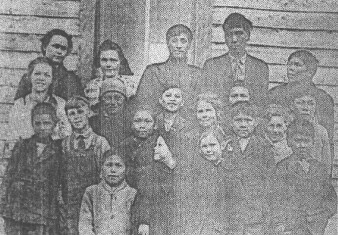
Elmo School-Early 1920's Top Row 4: Teacher,-, Alex
Couture, Pete Pierre, Mitch Mathias; Row 3; Lola Darr
Wolfinger, Angelic Beardog, Moody Stasso,
Joe Counture, Katherine Grant Huntley, Jim
Gran, Stan Young, Modeste Eneas; Row 2: Pete
Couture, Merlin Young,--,--, rest not identified,; Front
Row:--, Don Young,--,--,--, Auld -[Chief Cliff Picture]
The Elmo school enrollment was large in 1920-21. I believe there were eight whites and fifteen Indians. We never knew that we were the minority as such things were not thought of, I'm sure.
In 1921 the Matt School District #64 was annexed to Elmo School District. When the construction of Hubbard Dam was started in 1924 most of the cement and buildings were brought to Elmo by boat and hauled out to the construction site mostly by trucks with hard tires. The building of the dam was of great benefit to the vicinity of Lonepine and Hot Springs but the first settlers here had gradually given up and most of them had moved away.
Ilene Hyre came to teach at Elmo for the 1926-27 school year. It was her first teaching position and she had just graduated from Thompson Falls Normal (High School), three months short of being nineteen years old. Ilene was born in Indiana in 1907 to Eugene and Ethel Hyre. At five years old she came with her family to a homestead near Lonepine. So she knew the life of homesteaders and attended Sanders County country schools, including Garcon Gulch for a short time, remembering teacher Miss Evelyn Horn. Most of her Elmo students were Indian and some spoke little English. There were three white children. For two years Miss Hyre learned the Indian language as she taught English to the eleven students spread across eight grades. She never had a student in every separate grade of the eight grades. While living at Elmo Ilene Hyre boarded with the Crouch family. Mr. Crouch was a school trustee and Mrs. Anna Crouch was the district clerk. They had the store and post office. At 92 years old, Sam and Felicity Hewankorn and Cayes were the only names she could remember when Morris and Adell Bjorge interviewed her at Evergreen Care Center in Hot Springs. Her memory was pretty sharp as Sam Hewankorn is shown as eleven years old and sister Felicity was ten in 1926. Abraham and Josephine Caye were probably her students as they were seven and eight years old when Miss Hyre taught. Ilene Hyre left Elmo to teach for one year in Valier and fourteen more in another one room school at Tuscor by Thompson Falls. There she married Robert Iff and together they ranched the area until they retired in 1971 and moved to Thompson Falls. Mrs. Ilene Iff died in August of 1999 in Hot Springs.
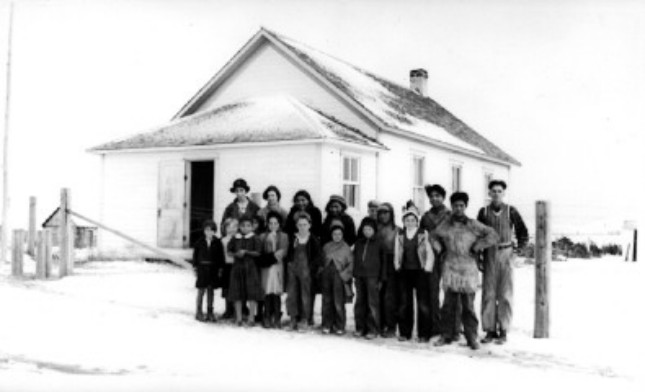
this 1935 picture of Mrs. Lillian Romasko and seventeen students from grades one to eight at the Elmo School. Those identified by Susan Antiste of Elmo Culture Committee include: 4th from L front Alice Finley, 3rd & 4th in back Cecile Finley, Nancy Finley; 8h in front Louie or Abe Caye; last 3 Eneas Hewankorn, Tony Mathias, -- Grant [Branson Photo]
Big Draw School 1931 to 1935
According to Jane Bower Weeks the Big Draw School was started in September 1931 on the Paul Bower ranch about six miles west of Elmo. The school house was a one room log cabin that had been moved from a site about two miles away. Jane did not know if the building was originally a school or the home of one of the early settlers. It was about 15 feet by 15 feet with a door on one end and a window on each side. It had two chalkboards approximately 5 feet by 6 feet, a teacher's desk, about eight student desks and a big wood-burning stove. There were nails on one wall for our coats and a small shelf for a water pail and a wash basin. One student brought a pail of water from home each morning. There was no provision for water, lights or plumbing. There was an outhouse behind the school. A cowbell was used to call the children to class.
The first two years of school (1931-32, 1932-33) there were five students in attendance; three girls and two boys, all members of the Bower family. Dorothy Dillon taught the first year with Marguerite Sorg teaching next and then left to teach at Valley View. Miss Mae Hendrickson taught there also but evidently as a substitute. In 1933, Mrs. Romosko, a teacher with a family was hired. That year there were seven children; four Bowers and three Romoskos. The school year of 1934-35, Mrs. Romosko was rehired and there were six children; three Bowers and three Romoskos. That was the last year school was held in the Big Draw School.
In 1935-36 Mrs. Lillian Romasko had 17 kids in grades 1-8 at the Elmo School. Big Draw was closed. For 1936-37 Nellie Standiford Harrison taught only five students.
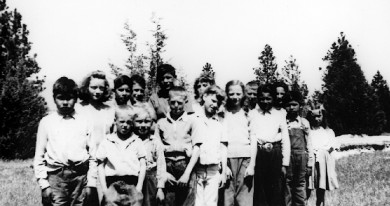
Elmo Students in 1944 Students: Deann Hayes, Marvin Saloway,
Shirlay Hayes, Shirley Hayes, Shirley Bower, Jimmy Hayes,
Huntleys & Others[Maas Collection]
The Forties
Emma Maas began years of service as a trustee in 1943 and continued on the board until 1970. By 1971-72 she served as district clerk and held that position until the school was abandoned in 1990. Lester and Emma purchased the Barr house one block from the school. Emma and Lester Maas continued to serve the nearby school throughout Emma's tenure as trustee and clerk. Lester often did maintenance work and kept the furnace functioning. Once Lester had to screw the bathroom windows down so an unhappy girl couldn't climb through to run away from school. Emma remembers the fun of board members and community folks getting together to pop corn at Francis Lawrence's "little brown house" over the wood stove to make the popcorn balls for the Christmas sacks. She said the best part of serving was the cooperation between everyone. Christmas programs with the stage, curtains, treats, and visits from Santa were standing room only. Many times the treat sacks would be filled at Emma's house and/ or the school. Mary Lefthand often helped sack treats and finally they got a good system going. For a long time the board provided a sack to everyone at the program until it got too expensive. She remembers filling 80 sacks many years. They had to cut back to giving sacks to the children only. One December Emma and Charlotte Wilhelm drove to Safeways at Kalispell after supper to shop for the sacks. When they left home in Emma's Pontiac station wagon there was no snow. By 9:00 p.m. after they stopped for pie and coffee they noticed it had begun to rain. By the time they drove to the State Park on the west shore there was six inches of snow and they couldn't see a thing.
Emma said that Elmo students hauled water from the lake until a well was drilled in 1953. Also parents and students volunteered to do the school cleaning. The west shore rural schools and Valley View combined competitive track meets every May. They were always a big day and well attended by adults, parents, and friends. The host school would present ribbons. Emma wrote:
In the fall of 1948 the woodshed was remodeled into a teacherage. By the following fall enrollment had increased to 34, requiring more space. There not being enough funds in the regular budget, application was made for an emergency budget. At the beginning of the second semester the building was ready and a second teacher, Mrs. Pauline Rude was hired to teach the lower grades, leaving Mrs. Ione Harris with the upper grades in the original building. Later this "woodshed" building was enlarged.
The high school portion of District #22 was consolidated to the Upper West Shore High School District #1 in 1949. However no high school was held in any of the west shore districts.
Building the New School in the Fifties
Eighth Grade Graduation in 1950 was held at Proctor with Proctor, Elmo, Rollins, Dayton, and Big Arm combined. Elmo students performed two poems on the program: "Opportunity" by Ingalls and "Psalm of Life' by Longfellow. Superintendent J. B. Kiracofe presented diplomas to three Elmo students: Shirley Duffield, Jasper Huntley, and Pete Stasso.
Emma Maas could still recall Pauline Rude teaching in the remodeled woodshed that had served as a teacherage before it was again remodeled for a classroom addition. That was how badly a new school was needed. Emma knows that Elizabeth Hahn taught in the old school because she clearly remembers being called over to help settle a discipline problem. Two girls were "snapping eyes at one another" and the teacher could not handle them. So she called over the trustee to give them a severe "talking to." Trustee Maas wrote:
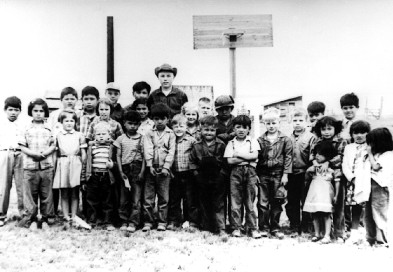
Elmo 1952-53 Back: Kenny Lefthand, Johnny Eneas, David
Maas, Jimmy Auld, Larry Maas, Kenny Jensen; Front; Earl
Auld, Rhoda Couture, Theresa Stasso, Doug Caye, Larry
"Butch" Wicker, Sandy Wicker, Donald Kenmille, Eddie
Eugene, Willie Caye, Lynn Maas, Joel Maas, Joe Eneas,
Betty Tenas, Monica Caye, Lorraine Caye, Evelyn Caye.
In December of 1949 an application was made for Federal Aid money to build a new building. With lots of patience and signing of many forms word was received in April 1953 from the Federal Security Administration that $12,675 was reserved for District 22 for a new building.
1952 Elmo eighth grade graduates were Roberta Wilhelm, Ignace Couture and Camille Mathias with Mrs. Hahn teaching the group to perform "It Is No Secret" and "That Lucky Old Sun" with the Big Arm students. Mrs. Hahn was both an accomplished pianist and singer and probably played along. Ignace and Camille paired up to do "Land, Sky, Water." The Upper West Shore districts consolidated for the high school combined resources to bus high school students to Polson. By July 3, 1952 the high school district was annexed into Polson High School District #23.
In September of 1952 "bids were opened and Mars Rolfson of Polson was awarded the contract for a new school building." By the end of December the building was done but there was not enough money to finish the bathroom floor tiles. Emma and Marilyn Jensen, wife of trustee Harland Jensen, worked over the Christmas vacation scrapping the tar off the classroom tiles on their hands and knees before "school started January 5, 1953 in the long awaited two room semi-modern building." Completion of the bathroom tiles awaited further funding, probably Johnson O'Malley funds for the next year. As funding became available the building was completely modernized. Emma credited all the trustees, the clerk, and Lake County Superintendent Kiracofe for giving generously with help and advice.
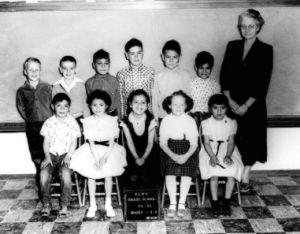
Elmo Grades 1,2,3 in 1953-55 Front: Willie Caye, Edna Lefthand, Barbara Caye, Elaine Jensen, Lorraine Caye; Back: Lynn Maas, Eddie Couture, Harold Irvine, Richard Nichols, Joe Eneas, Douglas Caye, Teacher Essie Siebert [Emma Maas Collection]
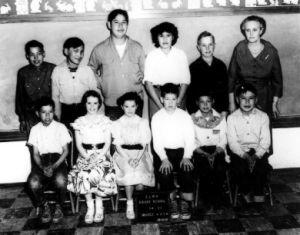
Elmo Grades 4,5,7&8 in 1954-55 Front: Earl Auld, Christine Eneas, Florence Bower, Kenny Jensen, Leroy Irvine, Johnny Eneas; Back : Lloyd Irvine, Eddie Eugene, Bernard Eneas, Bernice Eneas, Gary Maas, Teacher Nora Johnson [ Emma Maas Collection}
Larry Maas graduated from the new school in 1953 with Larry Wicker as his upper grade teacher. Larry later remarked that Elmo was a "valuable learning experience. Work from grade to grade with small classes. I learned well and was well prepared to go into high school." Emma's son Gary thought, "It was better in the rural school than the city. They should never have closed it." Essie McDonald Seibert taught the lower grades for three years starting in 1952. Mrs. Seibert taught the three previous years in the one-room school at Big Arm. Mrs. Seibert finished her teaching career at St. Ignatius. She passed away in June of 1998. Larry Wicker stayed only two years as there was some problem with his teachers certificate that would not meet elementary accreditation.
After the new school was completed, the first school was then used for a teacherage without an indoor toilet so the two outdoor privies were maintained. The topic of maintaining the school and teacherage continued yearly. Prior to school starting every fall both would be cleaned and the teacherage freshly "kimtoned." The topic of indoor plumbing for the teacherage constantly appeared throughout the minutes. By 1962-63 Ethel Terry wanted the outdoor privies removed from the school property but the board could not yet comply as they still did not have a septic system installed for the teacherage.
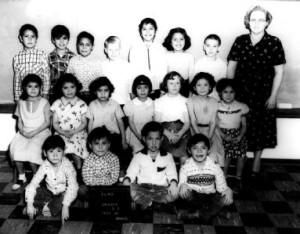
Elmo 1955-56 Grades 1,2,3 Front: Tommy Tenas, Arnold Irvine, Donald Kenmille, Willie Caye; 2nd R: Diane Andrew, Lorraine Caye, Delores Caye, Evelyn Caye, Elaine Jensen, Betty Tenas, Dorothy Couture; Back: Joe Stasso, Barbara Caye, Eddie Counture, Teacher Vera Hammond[Maas Collection]
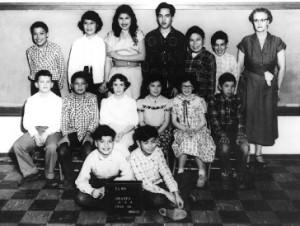
Elmo 1955-56 Grades 4,5,& 8 Front: Lawrence Kenmille, Jimmie Auld; Seated: Kenny Jemsen, Leroy Irvine, Christine Wilhelm, Levi Lozeau, Florence Bower, Earl Auld; Back: Llyod Irvine, Marie Andrew, Bernice Nichols, Teacher Nora Johnston [Maas colection]
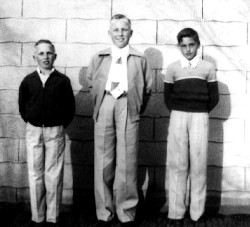
8th Grade Graduation 1953 Gary and
Larry Maas & Wilfred Kenmille.
Vera Hammond taught with Nora Johnston in 1955-56 and taught the next year with Martha Van Hellen Stiles. Martha Stiles had collected some individual pictures of the students.
A special board meeting was needed in August of 1959 between the board, County Superinten
dent Muriel Hamman, and some Indian parents who wanted to withdraw their children from Elmo and send them to Hot Springs to school. "Nothing definite was decided." By October the topic was still brewing and the Hot Springs Principal Earl Barlow and a Hot Springs trustee were contacted to see if they would take the students. They would not enroll the students without tuition and the board would not pay tuition so the matter seems to have died down for awhile.
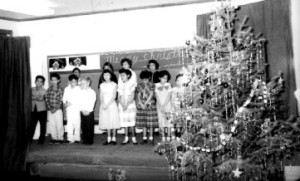
Chistmas 1956 at Elmo [Maas Collection]
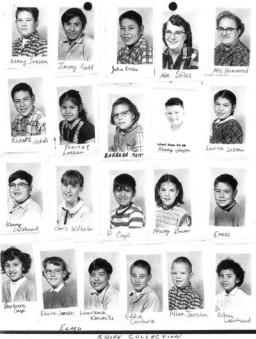
1956-57 Elmo Students: Kenny Jensen, Jimmy Auld, Johnny Eneas, Mrs. Stiles, Mrs. Hammond, Richard Nicholas, -Lozeau, -, Kenny Jensen, Levina Lozeau, Kenny Lefthand, Chris Wilhelm, D. Caye, Frosty Bower,- Eneas, Barbara Caye, Elaine Jensen, Lawrence Kenmille, Eddie Couture, Allen Jensen, Edna Lefthand [Carol Swope Collection]
Truancy and discipline issues pop up in minutes with a tribal officer serving as truancy official and the county attorney's office contacted for action - all with little apparent success.
The Sixties at Elmo
May 24, 1961 four of Ione Harris's students graduated in a combined West Shore Graduation with Elmo, Dayton, Proctor and Rollins. County Superintendent Muriel Hamman presented diplomas. Elmo graduates were Edward Couture, Lynn Maas, Wilbert Michel, and Harold Irvine. Lynn and Eddie performed readings.
Fabulous Flathead cites Elmo having 27 students in 1962 with Mildred Grant teaching. In the 1962-63 school year, the pupils of the upper grades of Elmo school presented an impressive flag program. Members of Fullerton VFW Auxiliary 2986 of Polson presented the school with a new 50-star American flag. School children, under direction of Mrs. Ethel Terry, had made and displayed official flags of the United States, from the first flag to the present one. The story of each flag was told by the pupils. Also on display in the classroom was an old Indian flag with real eagle feathers. Theflag was old and worn and no doubt had a lot of history on the Flathead Indians. Elmo has a modern two room school with two teachers-Mrs. Terry in the upper grades and Mrs. Page, lower grades. May Campbell Page lived at Dayton. All pupils except one are Indian children from the Elmo area. Presentation of the flag was made by Mrs. Lela Gore, national VFW Rehabilitation Director, and Mrs. Dean Bailey, Fullerton Auxiliary Senior
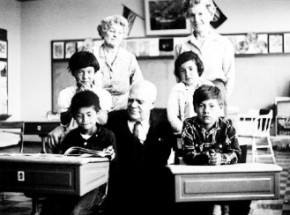
Elmo 1962-63 Theachers Ethel Terry and
May Page Standing; Middle: Francine
Mathias, Verna Lefthand; Front: -, Mr.-,
Francis Auld [Maas Collection]
Vice President. Mrs. Terry is also Americanism chairman and patriotic instructor of the auxiliary. Betty Tenas, on behalf of the school, accepted the flag and expressed students' appreciation. Other pupils attending and taking part in the program and flag raising were Tommy, Bernadine, Alvina and Doris Tenas, Christine Eneas, Arnold Irvine, Wynn Maas, Verna and Lori Lefthand, Francine and Toni Mathias, Frankie and Randy Tenas, Francis Auld, and Bobby Irvine.
Ethel Terry was born August 2, 1893, in Fairplaine, Missouri where she received her formal education. She attended Morrisville College in Morrisville, Missouri, and received her teaching certificate. She moved to Kansas where she met and married Leon F. Terry on May 28, 1914. . . .In 1936, the Terry's moved to Polson where she has reside since. Mrs. Terry was county school superintendent from 1935 through 1942. She also taught in local schools including Dayton, Ferndale and Elmo. She retired from teaching after teaching at Elmo the 1962-63 school year. Ethel Terry died in Polson in 1972. May Campbell Page was from Lonepine but was living at Dayton so she taught at Elmo while there. Today May Page lives south of Lonepine on the old Campbell place.
The sixties saw issues of consolidation with bordering Big Arm coming up as Big Arm enrollment declined. Elmo was the closest school and hoped to draw the Big Arm students there when the district closed. But instead Big Arm was annexed totally into Polson. No joint meetings were ever held between the two districts but Elmo hoped the northern portion of Big Arm where the Zimmermans and Boetchers lived would be annexed into Elmo District 22. Both families had to drive through Elmo to get to school in Polson.
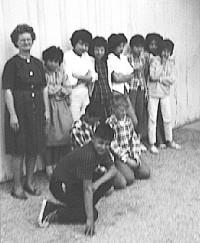
Della Sampson taught at Elmo from1963 to 1967 [Maas Collection]
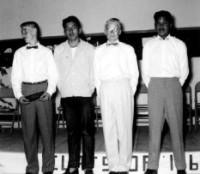
1961 Elmo Graduate: Eddie Couture, Wilbert Michel, Lynn Maas, Harold Irvine [Maas Collection]
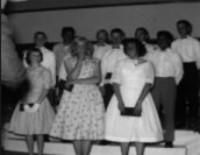
1961 Combined Graduates Front: Jeanne Thomas, Mary Ahlm, Barbara Matt; Back: Eddie Couture, Wilbert Michel, Lynn Maas,-,-, Harold Irvine,-, John McCroie [Maas Collection]
Mid sixties saw the beginnings of a hot lunch program which officially got started in the teacherage in 1966. For years the district tried to use $20,000 in reserves to build a hot lunch facility and storage facilities. Instead they ended up remodeling the teacherage for hot lunch program and getting in a mobile home for a teacherage. Cooks over the years were: Kathryn Webber, Mary Byrnes, Sarah Saloway, Betty Seifert, Ruby Burke, Tony Muller, Ruth -?-, and __?__the lady from Pablo/Ronan. In the process of remodeling for hot lunch, the indoor plumbing and sewer system problem were resolved. Kindergarten and special education services get started in the later sixties.
The Seventies at Elmo
In 1970 Elmo received a "probationary" accreditation warning from Montana's Office of Public Instruction so a special meeting was set up to address the issues March 17, 1970. Problems seem to have been:
The emergency teacher certification of Myrtle Cutler,
The need for updated textbooks,
Physical education for 45 minutes a week besides recesses and lunch;
More library books with a move up to ten per student with one periodical per grade;
Professional development for teachers in addition to board meeting attendance; and
Chest x-rays were required for hot lunch personnel
Apparently the board resolved all issues by the following year.
District Clerk Emma Maas wrote, "" Additional teachers up to five per year plus aides, a janitor and a secretary were added throughout the seventies. A trailer was rented for temporary remedial reading classrooms and appropriate teachers were hired. Remedial reading needs were an issue throughout the seventies. Also the district cooperated with the community and tribal offices to sponsor an Adult Basic Education program at Koostatah Hall. Elmo jointly formed an Indian Education Cooperative Unit with Dayton and hired Dr. Lyle Berg for administrative advice. They brought in two mobile units purchased from the Mission Mountain College in Polson and used them for the extra classes offered.
Declining Enrollment in the Eighties
Enrollment gradually declined throughout the eighties and the need for teachers dropped. In 1980 to 1982 three teachers served, then 1982-82 had two teachers Genevieve Clement and Janet Peterson. From then on only one teacher was needed. The extra mobile units and the lunch room equipment were sold off leaving the new two classroom school, the original school, and a mobile home used for a teacherage at the school site. There were brief hopes of increased population in the area as Hog Heaven Mines were doing a feasibility study to reopen. They projected 75-100 jobs for the area if the study proved positive. Area residents were invited to a community meeting June 15, 1983 at Nirada. Nothing materialized.
The last year a class was held at Elmo appears to be 1986-87 when Penny S. Hamilton taught one student Desiree Joseph. Penny lived in the teacherage. With the enrollment declines it was not feasible to continue offering school. County Superintendent Ferrell guided the district through their options and assisted with the closing process. The district became a nonoperating district for three years prior to annexation to an adjoining district. The board and district clerk Emma Maas continued in office until the district was abandoned July 1, 1990 during the last year of Mrs. Glennadene Ferrell's service as Lake County Superintendent of Schools. Emma reported that the ending of the district was "a sad time for many." During that period the board posted notice for sale of the trailer that had been the teacherage. It was eventually sold to Walter Radel who did not remove it until the district belonged to Polson. Also in 1989 some parents petitioned to reopen the school but County Superintendent Ferrell could only determine two official students that would attend Elmo and five were required for consideration of reopening.
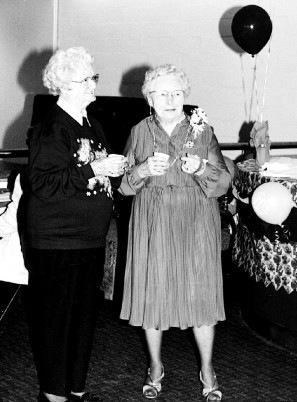
Della Sampsdon Cook and Emma Maas
Celebrating Emma's 80th Birthday.
The Elmo school house was used for church and youth services, a tribal language program, and Tribal Head Start for some years. The land and buildings were offered for sale by Polson District 23 trustees in January of 1991. It was purchased by the tribe in 1991.
In 1991 the board presented longtime clerk and trustee Emma Maas with a walnut plaque at a special dinner held in her honor: Emma W. Maas IN APPRECIATION OF 47 YEARS OF DEVOTION & SERVICE TO SCHOOL DIST. #22. ELMO, MT. JULY 1990. Those that attended to honor District Clerk Emma Maas were: Chris and Trustee Sue Olson, Mr. and Trustee Gladys Pearson, George and Trustee Diane Dahl and long time teacher Ione Harris.
